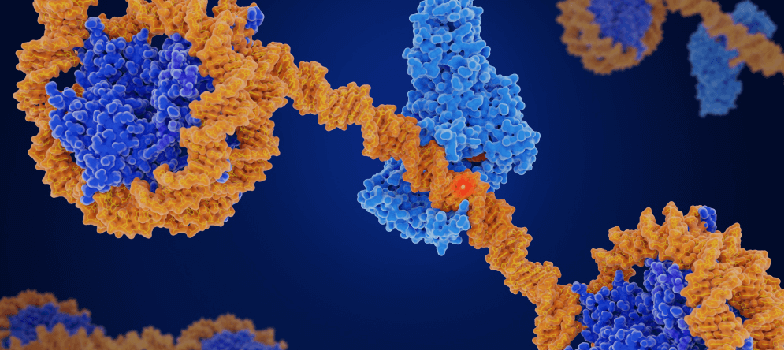<< Back to MOTIFvations Blog Home Page
LINE-1 Transposable Elements: Can they Provide Liquid Biopsy Biomarkers for Early Cancer Detection and Management?

April 4, 2023
Table of Contents:
-
Introduction: The Ongoing Need for Ovarian Cancer Biomarkers
-
ORF we go! High-Sensitivity Detection of ORF1p in Liquid Biopsies
-
ORF1p Detection in Patient Plasma: Towards the Development of a Candidate Ovarian Cancer Biomarker
-
LINE-1 ORF1p as a Blood-based Multi-cancer Biomarker?
-
LINE-1: A New Paradigm for Cancer……and Aging?
Introduction: The Ongoing Need for Ovarian Cancer Biomarkers
While we have made great leaps and bounds in the early diagnosis and treatment of certain tumors, ovarian cancer remains as a leading cause of cancer-related mortality in developed countries (Zheng et al.), with vast numbers of new cases and deaths reported in 2022 in the USA alone (Sung et al. and Siegel et al.). Patients with high-grade serous ovarian carcinoma (or HGSOC) - the most common subtype – often become diagnosed only at advanced disease stages where outcomes are generally poor. A sensitive and specific screening test for a broadly applicable biomarker has the potential to significantly improve patient outcomes and survival by diagnosing the disease at earlier stages. The analysis of biomarkers present in easily accessible bodily fluids (so-called "liquid biopsies"), which can comprise components such as circulating tumor cells, extracellular vesicles, RNA, DNA, proteins, and metabolites, may represent a minimally invasive and effective path forward. Of note, repeat-element content (Gezer, Bronkhorst, and Holdenrieder) and DNA methylation status (Ponomaryova et al.) of the cell-free DNA component of liquid biopsies have recently been highlighted as potentially exciting biomarkers for the early-stage diagnosis of breast cancer (Sunami et al.) and melanoma (Hoshimoto et al.) and disease progression monitoring in colorectal cancer (Nagai et al.).
Taking an alternative but complementary protein-centric view of liquid biopsies, recent unpublished research from the lab of Ronny Drapkin (University of Pennsylvania) compared the protein composition of tissue interstitial fluid (Ura et al.) from normal fallopian tube epithelium and matched HGSOC. Interestingly, they discovered ORF1 protein (ORF1p) - a high-affinity, non-sequence-specific RNA binding protein with nucleic acid chaperone activity as among the most specifically overexpressed proteins in HGSOC. ORF1p is encoded by the long-interspersed element-1 (LINE-1) retrotransposable element (Cordaux and Batzer and Ostertag and Kazazian). A wide range of additional studies of epithelial cancers have also noted the aberrant expression of LINE-1 ORF1p; therefore, researchers have begun to ask whether ORF1p may represent a promising cancer biomarker detectable in liquid biopsies of patients with ovarian (and perhaps other) cancers.
ORF we go! High-Sensitivity Detection of ORF1p in Liquid Biopsies
In a recent Scientific Reports study, researchers headed by Ronny Drapkin now report a highly sensitive means to detect LINE-1 ORF1p in a range of biological fluids, which provides additional impetus for further research into ORF1p as an ovarian cancer biomarker (Sato et al.). In a related study, a bioRxiv Pre-print from collaborators led by Martin S. Taylor, David R. Walt, and Kathleen H. Burns takes one step beyond ovarian cancer by suggesting LINE-1 ORF1p present in liquid biopsies as a multi-cancer biomarker and highlighting an ultrasensitive ORF1p assay as a novel, rapid, cost-effective tool in cancer diagnosis and long-term management (Taylor et al.).
ORF1p Detection in Patient Plasma: Towards the Development of a Candidate Ovarian Cancer Biomarker
In the first of our studies, a team led by Ronny Drapkin developed some nifty tech – the "immuno-multiple reaction monitoring followed by mass spectrometry" or "iMRM-MS" assay that detects two proteotypic ORF1p peptides - to confidently detect ORF1p released into the conditioned media of HGSOC and primary tumor cells, patient ascitic fluid samples, and patient plasma samples. The iMRM-MS assay possesses several critical features which ensure that the measurement derives from the intended analyte, including high-level multiplexing of biomarker candidates with efficient sample processing, enhanced analytical sensitivity, and sequence specificity (thanks to mass spectrometry). Notably, the iMRM-MS assay also recapitulated the findings of Western blotting experiments in HGSOC and primary cell line supernatants. Overall, this study supports an effective means of detecting ORF1p in liquid biopsies as a biomarker of HGSOC development. However, the authors do note the need to improve the limits of quantification of their assay and continue evaluations in patients to gain more precise quantitative estimates of ORF1p’s performance as a biomarker in liquid biopsies.
Interestingly, further immunohistochemical analysis of various tissue specimens revealed that HGSOC precursor lesions (serous tubal intraepithelial carcinoma or STIC) expressed ORF1p, while benign fallopian tube epithelial cells do not, highlighting ORF1p expression as an early event in HGSOC development. The authors also discovered that treatment of fallopian tube epithelial cells with DNA methyltransferase inhibitors prompted the depletion of DNA-methyltransferase 1 and a decrease in LINE-1 DNA methylation (via Active Motif's Global DNA Methylation Assay–LINE-1 for the quantification of global 5-mC levels in DNA), which supported the robust expression and release of ORF1p. These data experimentally validate the regulatory role of DNA methylation in LINE-1 repression in non-tumorigenic tissue and highlights the potential for DNA methylation analysis of repeat elements as another potential disease biomarker (Cordaux and Batzer, and Burns, 2017). Overall, the additional findings from this exciting study highlight the potential of LINE-1 ORF1p as a biomarker for the early diagnosis of HGSOC and reinforce the importance of epigenetic mechanisms such as DNA methylation in controlling the activity of retrotransposable elements. Early diagnosis remains a crucial aspect of HGSOC management; therefore, ORF1p detection may help to significantly improve patient outcomes by identifying patients requiring treatment at early disease stages and perhaps even stratifying patients into different treatment groups.
For more on how the LINE-1 ORF1p cancer biomarker in liquid biopsies may significantly improve HGSOC patient outcomes, see Scientific Reports, January 2023.
LINE-1 ORF1p as a Blood-based Multi-cancer Biomarker?
While the previous study raises hopes for the early diagnosis and optimized long-term management of HGSOC, an associated study headed by Martin S. Taylor, David R. Walt, and Kathleen H. Burns (currently a pre-print) aimed to highlight the potential of LINE-1 ORF1p as a blood-based multi-cancer biomarker; one that will support the development of novel, rapid, cost-effective tools in cancer diagnosis and disease monitoring in general. In their study, the researchers described the landscape of ORF1p plasma levels across multiple cancers, developed high-sensitivity assays for applications in early/minimal-residual disease detection, and provided evidence for plasma ORF1p as an early indicator of therapeutic responses.
In brief, the team engineered ultrasensitive digital immunoassays (Single Molecule Arrays or SIMOA) (Cohen, Keegan, and Walt) for the high-specificity detection of mid-attomolar (10-18) concentrations of ORF1p in plasma samples taken from individual patients suffering from differing types of cancer. Their study confirmed the potential of plasma ORF1p detection in the early diagnosis of ovarian cancer (as reported above) but also described how plasma ORF1p could improve diagnostic performance in a multi-analyte panel and support early therapeutic response monitoring in gastric and esophageal cancers.
We look forward to fully exploring this study following successful peer review; for now, read about how LINE-1 ORF1p may represent a multi-cancer biomarker in liquid biopsies in their bioRxiv Pre-print.
LINE-1: A New Paradigm for Cancer……and Aging?
Overall, LINE-1 offers the potential to significantly improve early cancer diagnosis and long-term management; but we are here to tell you that this retrotransposable element is involved in so much more! Check out this talk from Bing Ren at Chromatin-Con 2023: Epigenetics of Aging on how chromatin accessibility associates with increased activation of LINE-1 elements during aging and download this new eBook from Active Motif to gain insight into critical epigenetic alterations and molecular targets in cell senescence, which includes the derepression of transposable elements in aging.
About the author

Stuart P. Atkinson, Ph.D.
Stuart was born and grew up in the idyllic town of Lanark (Scotland). He later studied biochemistry at the University of Strathclyde in Glasgow (Scotland) before gaining his Ph.D. in medical oncology; his thesis described the epigenetic regulation of the telomerase gene promoters in cancer cells. Following Post-doctoral stays in Newcastle (England) and Valencia (Spain) where his varied research aims included the exploration of epigenetics in embryonic and induced pluripotent stem cells, Stuart moved into project management and scientific writing/editing where his current interests include polymer chemistry, cancer research, regenerative medicine, and epigenetics. While not glued to his laptop, Stuart enjoys exploring the Spanish mountains and coastlines (and everywhere in between) and the food and drink that it provides!
Contact Stuart on Twitter with any questions
Related Articles
LINE-1 Elements: Walk the LINE-1
September 13, 2022
While LINE-1 elements have been vital for fueling genetic variation and human evolution, their repression and that of other transposable elements is crucial to maintain homeostasis in cells so that our genomes continue to walk the line! Read how rogue LINE-1 expression is a target for combating its role in disease and aging.
Read More
DNA Methylation for Predicting Prostate Cancer: Where Do We Stand?
December 13, 2022
Some say that Epigenetics touches everything. The marriage between DNA methylation, one of the earliest and most studied of epigenetic mechanisms, and its potential to be a powerful biomarker for disease is exciting and promising. In this overview, we look at prostate cancer research in particular - where we stand in this regard, and also a “new” biomarker associated with voltage-dependent calcium channels!
Read More
<< Back to MOTIFvations Blog Home Page








